- Mitsubishi Galant
-
This article is about the car. For the musical style, see Galante music. For the Mitsubishi Galant Fortis, see Mitsubishi Lancer.
Mitsubishi Galant 
Manufacturer Mitsubishi Motors Production 1969–present Assembly Okazaki, Aichi (1969–2006)
Port Melbourne, Australia (1971-72)[1]
Tonsley Park, Australia [2] (1972-2008)
Normal, United States (1993–present)
IndonesiaClass Compact (1969–98)
Mid-size (1996–present)Body style 4-door Sedan
5-door Hatchback
2-door Hardtop
4-door Hardtop
5-door WagonThe Mitsubishi Galant is an automobile manufactured by Mitsubishi Motors since 1969. The name was derived from the French word galant, meaning "chivalrous".[3] There have been nine distinct generations, and cumulative sales now exceed five million.[4] It began as a compact sedan, but over the course of its life has evolved into a larger mid-size car. Initial production was based only in Japan, but since 1994 the American market has been served by vehicles assembled at the former Diamond-Star Motors (DSM) facility in Normal, Illinois.
Contents
First generation
First generation 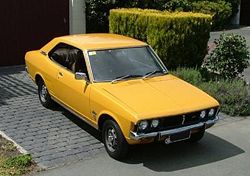
Also called Colt Galant
Dodge Colt
Chrysler Valiant GalantProduction 1969–73 Predecessor Mitsubishi Colt 1100 Class Compact Body style 2-door hardtop sedan
4-door sedan
5-door station wagonLayout FR layout Engine 1.3 L 4G30 I4
1.4 L 4G33 I4
1.5 L 4G31 I4
1.6 L 4G32 I4
1.7 L 4G35 I4Wheelbase 2,420 mm (95.3 in) Length 4,080 mm (160.6 in) Width 1,560 mm (61.4 in) Height 1,370 mm (53.9 in) The first generation of the car, initially known as the Colt Galant, was released in December 1969. The design was dubbed "Dynawedge" by Mitsubishi, referring to the influence of aerodynamics on the silhouette.[4] Three models were available, powered by the new 'Saturn' engine in 1.3 (AI model) or 1.5 L (AII and AIII) configurations. 1.4 and 1.6 litre versions (14L and 16L) replaced these in September 1971, and a larger 1.7 followed in January 1973. Initially only available as a four-door sedan, a five-door estate and two-door hardtop variant were added in 1970, the hardtop offering the unique stylistic feature of being the first Japanese production passenger car with full side windows and no side pillars. It became Mitsubishi's first car to be sold in the United States in 1971 when the Chrysler Corporation, the company's new partner and stakeholder, began importing the car as the Dodge Colt. It was also produced by Chrysler Australia and sold alongside the larger Chrysler Valiant models as the Chrysler Valiant Galant.[5]
From 1970, a fastback coupé model was developed, the Galant GTO. Fashioned after contemporary American muscle cars, the hardtop GTO was available with a choice of two "Saturn" engines and the 2-litre Astron 80, and was available until 1975. The nameplate was sufficiently highly regarded in Japan for it to be resurrected for the 1990 Mitsubishi GTO coupé.
A second, more compact coupé was introduced on a chassis shortened by 12 cm in 1971, the Galant FTO. Powered by the 4G41 1.4 L engine, it too would leave a legacy for the company to return to in the 1990s with the Mitsubishi FTO.
New Zealand
Although the earlier Colt had been imported in limited numbers, this generation, in 1.6L coupe form only, was the first model to establish the Mitsubishi brand in New Zealand from 1971 when newly-appointed distributor Todd Motors, which also imported and assembled Chrysler and Hillman, started selling a small number of Japanese-assembled cars to supplement its mainstream Hillman Avenger and Hunter models.
The coupe was assembled in New Zealand from 1972, firstly at Todd's Petone factory, on the Avenger/Hunter line and, from 1974, at the brand-new purpose-built factory in Porirua (closed in 1998).
Second generation
Second generation 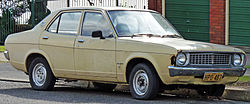
Also called Colt Galant
Chrysler Valiant Galant
Chrysler Galant
Dodge Colt
Plymouth Colt
Plymouth CricketProduction 1973–1976 Class Compact Body style 2-door coupe
4-door sedan
5-door station wagonLayout FR layout Engine Astron I4
4G32 1.6 L I4Wheelbase 2,420 mm (95.3 in) Length 4,204 mm (165.5 in) Width 1,600 mm (63.0 in) Height 1,397 mm (55.0 in) Curb weight 940 kg (2,100 lb) The second generation Galant was more widely exported as Mitsubishi's ambitions grew. It was again sold by Chrysler in many different guises; as the Dodge Colt in the United States, as the Plymouth Colt and Plymouth Cricket in Canada (from 1974),[6] as the Chrysler Valiant Galant and (from 1976) as the Chrysler Galant in Australia,[7] and in Europe as the Colt Galant.
The coupe, now with an 1,850 cc engine was again assembled in New Zealand by Todd Motors at Porirua. The sedan was not offered as Todd was planning to assemble the larger Galant Sigma sedan and wagon range from late 1977 and was still also importing the British Avenger and Hunter models.
This new Galant model was more curvaceous, influenced by contemporary "coke-bottle" styling, and featured a range of larger 'Astron' engines developing up to 125 PS to complement the 'Saturn' units. During the second generation, the first Astron 80 engines were introduced in some markets using Mitsubishi's newly developed "Silent Shaft" balance shaft technology for reduced vibration and noise.
Third generation
Third generation 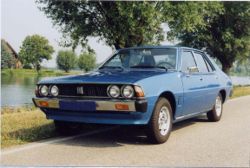
Also called Mitsubishi Galant Sigma
Chrysler Sigma
Mitsubishi Sigma
Colt Sigma
Dodge ColtProduction 1976–80 Class Compact Body style 2-door coupé (Lambda)
4-door sedan
5-door station wagonLayout FR layout Engine 1.6 L 4-cylinder (Saturn)
1.85 L 4-cylinder
2.0 L 4-cylinder
2.6 L 4-cylinderWheelbase 2,515 mm (99.0 in)[8] Length 4,330 mm (170.5 in)[8] Width 1,655 mm (65.2 in)[8] Height 1,355 mm (53.3 in)[8] The third-generation of the car was introduced in 1976, and was known as Galant Σ (Sigma). In many export markets the car was simply known as the Galant. At that time, the Dodge Colt in America was actually a Mitsubishi Lancer, not the Galant anymore, but nonetheless the Galant Wagon variant was sold with the Dodge Colt label in the US and Canada. In Australia, where the car was made locally at Chrysler's Clovelly Park plant, it was known as the Chrysler Sigma and, after the buyout of Chrysler Australia by Mitsubishi, as the Mitsubishi Sigma. Australian content was quite high and included a locally-made 2.6-litre 'Astron' four in place of the 1.6, 1.85 and two-litre engines used in other export markets.
A new coupé (two door) was introduced in 1976 to replace the Galant GTO. It was known in Japan as the Galant Λ (Lambda). The coupe was sold in the United States between 1978 and 1980 as the Dodge Challenger and Plymouth Sapporo.
Mitsubishi introduced the MCA-Jet engine for Japan and other emissions-controlled markets with its latest Galant. This incorporated the "Jet Valve", a secondary intake valve which improved emissions without necessitating the need for a completely redesigned cylinder head. In 1978, Mitsubishi in Japan established a dedicated dealership sales channel called (Japanese: Galant Restaurant) to sell the Galant and other selected vehicles.
Todd Motors initially assembled 1.6GL, 1.85GLX and two-litre GLS sedan models for New Zealand, with the GLS getting a five-speed manual transmission as standard with three-speed auto optional. These were the first NZ-assembled Mitsubishis to have rear screen demisters as standard. Early cars had conventional rod-suspended headliners developed locally to meet local content rules but these were notorious for collapsing on to the passengers' heads and were quickly replaced by newly developed, glued-in moulded foam liners. The range was later revised to add the wagon and drop the 1.85-litre engine.
The third generation Galant was the recipient of the Car of the Year award in South Africa in 1977.[9]
Fourth generation
Fourth generation Also called Mitsubishi Eterna Σ
Mitsubishi Sigma
LonsdaleProduction 1980–87 Class Compact Body style 2-door coupé (Lambda)
4-door sedan
5-door station wagonLayout FR layout Transmission 5-speed manual
3-speed automaticMitsubishi's fourth iteration of the Galant Σ/Eterna Σ debuted many new innovations for Mitsubishi. Their new 'Sirius' engine was offered in turbocharged form for performance enthusiasts in some markets, while for economy, an 'Astron' 4D55, the first diesel engine in a Japanese passenger car, was also offered. A new electronic fuel injection system was introduced on some versions of the gasoline Astron engine. The car was sold as the Mitsubishi Galant in most export markets, although in Australia it was known as the Mitsubishi Sigma.
For the second generation in a row Mitsubishi could claim to be building an award-winning car, as this was chosen as Car of the Year in New Zealand in 1981. The cars sold there were again locally assembled with 1.6 and two-litre engines, and a choice of transmissions and trim. As elsewhere (see below), the wagon versions carried over the old body style with a new nose and interior.
From 1982 to 1983, some of the Australian Sigmas, which had the carried-over 2.6-litre, locally made engine, were exported to the United Kingdom with the Lonsdale badge, circumventing the voluntary import quota restrictions adopted by Japanese manufacturers. However the car was unsuccessful, and for 1983 and 1984 it carried Mitsubishi Sigma badges in the UK before imports were discontinued.
The wagon version was facelifted, although from firewall back the vehicle remained the same. Production of the wagon version continued in Australia until 1987 when it was replaced by the new Magna.
The two door coupé was also redesigned for 1980 and was sold through 1983. While continuing with the Galant Λ/Eterna Λ label for the domestic Japanese market, the fourth generation was known as the Mitsubishi Scorpion in Australia, and the Dodge Challenger and Plymouth Sapporo in the United States.
The fourth generation sedan and coupé were both slightly larger than the third generation cars. Additional emphasis was given to ergonomics, aerodynamics, and safety. Shoulder room, leg room, and head space were all increased, and the trunk was slightly enlarged for more luggage capacity. The interior was made quieter with additional carpeting and other acoustic dampening materials and a double-thickness front bulkhead.
Fifth generation
Fifth generation 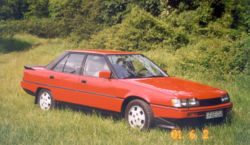
Also called Mitsubishi Eterna
Mitsubishi Sigma
Mitsubishi V3000
Mitsubishi MagnaProduction 1983–92 Class Compact Body style 4-door sedan
4-door hardtop sedanLayout FF layout Engine 1.6 L Saturn I4
1.8 L Sirius 4D65 I4 TD
2.0 L Astron I4
2.0 L Astron I4 turbo
3.0 L 6G72 V6Related Mitsubishi Magna
Mitsubishi V3000A fifth-generation model shifted to front-wheel drive for 1983 as a four-door sedan and hardtop (with different styling). This formed the basis of the widened (by 4 inches/100mm) Mitsubishi Magna in Australia for 1985, the same year in which Mitsubishi won Bild am Sonntag's Das Goldene Lenkrad (Golden Steering Wheel) award in Germany for the Galant and Wheels’ Car of the Year for the Magna.[10] This generation was also sold as the Mitsubishi Sigma until 1990 in the United States. The station wagon was replaced by the Mitsubishi Chariot.
Export trim levels were often engine-specific, depending on the market: GL models were offered with either 1.6L or 1.8L engines, GLS models (GLX in some markets) had 2.0-litre engines (badged 2000 GLS) and Diesel versions had a 1.8-litre Sirius turbodiesel engine. The diesel model did not have a trim level, it was simply the 1800 TD.
The initial 1984 cars assembled by Todd Motors in New Zealand again were built with 1.6 and two-litre engines, the latter with an automatic option and three trim levels. The top SE version had salmon coloured velour upholstery and numerous electronic gadgets including digital dashboard, automatic climate control with the brand's first factory-fit air conditioner, cruise control and speed-dependent intermittent wipers. The salmon/brown interior was replaced with a deep red as a running change around 1985.
This generation was replaced in 1988 by the sixthe generation Galant (see below) and supplemented by the unique-to-NZ V3000 range, with three-litre V6 engine, which remained in production until 1992. It was developed specially to give Mitsubishi New Zealand (which bought out Todd Motors in 1987) a six cylinder family car, suitable for towing boats and caravans, to compete with the Ford Falcon and Holden Commodore and was not sold in any other market.
Sixth generation
Sixth generation 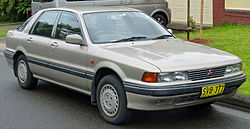
Also called Mitsubishi Eterna
Dodge 2000GTX (Canada)
Eagle 2000GTX (Canada)
Mitsubishi ZX/MF/MS/MX (Venezuela)Production 1987–1993 Class Compact Body style 4-door sedan
4-door hardtop sedan
5-door hatchbackLayout Front engine, front-wheel drive/four-wheel drive Engine 1.6 L
1.8 L DOHC
2.0 L 102 hp (76 kW) I4
2.0 L 135 hp (101 kW) I4
2.0 L 197 hp (147 kW) turbocharged I4Transmission 4-speed automatic
5-speed manualWheelbase 2,600 mm (102.4 in) Length 4,670 mm (183.9 in) Width 1,695 mm (66.7 in) Height 1,360 mm (53.5 in) Related Eagle Talon
Mitsubishi Galant VR-4
Mitsubishi Eclipse
Plymouth LaserIn 1987 the same platform was used for a sixth-generation model which adopted taller, rounded styling. This generation won the Car of the Year Japan award in 1987 and the GS model became Motor Trend's Import Car of the Year in 1989.[11] This Galant began American sales in 1989 side by side with the Sigma.
In 1991, Mitsubishi Motors Company completed a new assembly facility at Barcelona, Venezuela with the Galant being one of the first models produced. It was sold until 1994 under the ZX, MF, MS and MX names, which identified the various levels of equipment and transmission.
The Sigma designation disappeared with the 1990 model. A new hardtop liftback model was added in 1988, called the (Japanese: Mitsubishi Eterna). This generation was also sold in Canada as the Dodge 2000GTX and Eagle 2000GTX. Sales ended in 1993.
A limited edition based on the GTi-16v model was introduced in 1989, modified by German tuning company AMG (now owned by Mercedes-Benz), with mildly uprated engine (172 PS (127 kW; 170 hp)) and unique bodykit, alloy wheels & leather interior.
The sixth generation was also the first to see the introduction of the VR-4 variant, which was the basis for Mitsubishi's participation in the 1988–1992 World Rally Championships. The Galant's 4G63 two litre DOHC turbocharged engine and 4WD transmission was later adopted for the Mitsubishi Lancer Evolution with little modification, and would remain in production for fifteen years.
Safety
National Highway Traffic Safety Administration (NHTSA) crash test ratings for 1991–1993 Galant[12]:
- Frontal Driver:





- Frontal Passenger:





- Side Driver: Not Rated
- Side Rear Passenger: Not Rated
- Rollover: Not Rated
Seventh generation
Seventh generation 
Also called Mitsubishi Emeraude
Mitsubishi EternaProduction 1992–98 Class Compact Body style 4-door sedan
4-door hardtop sedan (Emeraude)
5-door hatchbackLayout Front engine, front-wheel drive/four-wheel drive Engine 1.8 L I4
2.0 L I4
2.4 L I4
1.8 L V6
2.0 L V6
2.0 L V6 twin turboTransmission 5-speed manual
4-speed automaticWheelbase 2,635 mm (103.7 in)[13] Length 4,625–4,640 mm (182.1–182.7 in) Width 1,730 mm (68.1 in) Height 1,395–1,400 mm (54.9–55.1 in) Curb weight 1250 kg (2755 lbs)[14] Related Mitsubishi Galant VR-4
Proton PerdanaA new Galant debuted in 1992 (model year 1994 in America), available as a four-door sedan and five-door liftback (sedan only in America). A Japan-only hardtop derivative called the (Japanese: Emeraude) (French for emerald) was also launched in 1992. This generation marked a substantial change in suspension design. The front switched from struts to a multi-link structure featuring two lower arms and one upper arm. The rear switched from a beam axle to a newly designed multi-link system. Both designs would carry over to the second generation Mitsubishi Eclipse and its sister vehicles.
Because the Lancer Evolution was now Mitsubishi's homologated rally car, the seventh generation VR-4 became a less overtly sporting vehicle, eschewing the old four-cylinder engine in favour of a smoother two litre V6 twin turbo. The four wheel drive transmission was retained.
Production in the United States began on May 24, 1993 when the first seventh generation Galant rolled off the assembly line in Normal, Illinois. In 1994, a slightly upgraded GS version was available with a 160 hp (120 kW) twin cam engine, speed-sensitive steering, rear stabilizer bar, and an available manual transmission.
The seventh generation Galant, also known as the Mitsubishi Eterna, formed the basis of the Proton Perdana.
Safety
National Highway Traffic Safety Administration (NHTSA) crash test ratings for 1997 and 1998 Galant[15]:
Eighth generation
Eighth generation Also called Mitsubishi Legnum
Mitsubishi Aspire
Mitsubishi MX/MF
Mitsubishi VRG
Mitsubishi VRM(Hong Kong)Production 1996–2003 Class Mid-size Body style 4-door sedan
5-door station wagon (Legnum)Layout Front engine, front-wheel drive/four-wheel drive Engine 1.8 L 4G93 GDI I4
2.0 L 4G63 I4
2.0 L 4G94 I4
2.0 L 6A12 V6
2.4 L 4G64 I4
2.5 L 6A13 V6
2.5 L 6A13TT V6 twin turbo
3.0 L 6G72 V6Transmission 4-speed automatic
5-speed manual
5-speed semi-automaticWheelbase 2,635 mm (103.7 in) Length 4,660 mm (183.5 in) Width 1,740 mm (68.5 in) Height 1,410–1,420 mm (55.5–55.9 in) Curb weight 1336 kg (2945 lbs)[16] Related Mitsubishi Legnum
Mitsubishi Galant VR-4The eighth-generation 1996 model continued the 1992 design themes but a station wagon (known in Japan as the Mitsubishi Legnum) was added while the liftback was removed from lineup. This model won the 1996–97 Car of the Year Japan award. Despite being superseded in the US from 2003, it remained on sale in other countries until 2006.
This model was also produced in Barcelona, Venezuela, at the only Mitsubishi plant in Latin America. At the beginning, the Galant was marketed in that country under the MX and MF names in 1997 and 1998 (Featuring a manual or INVECS-II semi-automatic transmission respectively), then kept the Galant name until the end of its production in 2006. Although the equipment options were limited, the VR-4 appearance package was offered in that market.
The American market Galant, introduced on July 7, 1998, graduated to the US Environmental Protection Agency's mid-size class. The front suspension switched from double-wishbones to struts, though the rear was upgraded with a stabilizer bar standard on all but the base DE model. ES, LS and GTZ models were offered with a 195 hp (145 kW) V6 engine, the 6G72 3.0 L, mated to a standard 4-speed conventional auto. Another difference from Asian and European models was lack of ABS, which was only installed on 3.0 L model.
Mitsubishi opted to further develop the technology in its range-topping VR-4, which was now powered by an enlarged 2.5 L V6 twin turbo. The car featured either a conventional 5-speed manual or INVECS-II transmission . Some models were also fitted with the same advanced active yaw control (AYC) as the Lancer Evolution, to give it greater agility than would be expected of such a large vehicle. Finally, as with the rest of the range, the VR-4 could now be had either as a Galant sedan or as a Legnum station wagon.
In some Asian markets Mitsubishi offered a 2.0 L MIVEC version of the 6A12a high revving naturally aspirated V6 race engine with a sports ECU engine management module, badged as the "Galant 2.0A", or alternately as the VR-M.This engine was also found on Mitsubishi's mid size sports car the FTO-GPX. Output was placed at 200 hp (150 kW) and 147 lb·ft (199 N·m) of torque. The larger 2.5 L 6A13 was more common in the rest of the world.
In 1998 the company introduced the Mitsubishi Aspire. Externally identical to the regular Galant, the new model name denoted the newly-introduced gasoline direct injection (GDI) engines.
Safety
National Highway Traffic Safety Administration (NHTSA) crash test ratings for 2001 Galant without side airbags[15]:
National Highway Traffic Safety Administration (NHTSA) crash test ratings for 1999–2002 Galant with side airbags[15]:
Ninth generation
Ninth generation 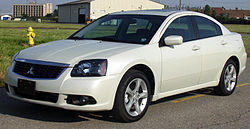
Also called Mitsubishi Grunder (Taiwan)
Mitsubishi 380Production 2004–present Class Mid-size Body style 4-door sedan Layout FF layout Platform Mitsubishi PS platform Engine 2.4 L 4G69 I4
3.8 L 6G75 V6
3.8 L 6G75 V6 MIVECTransmission 4-speed automatic
4-speed semi-automatic
5-speed semi-automaticWheelbase 108.3 in (2,750 mm) Length 190.4–191 in (4,840–4,900 mm) Width 72.4 in (1,840 mm) Height 57.9–58.2 in (1,470–1,480 mm) Curb weight 1540 kg (3395 lbs) ES/LS[17][18]
1696 kg (3739 lbs) Ralliart[19]Related Mitsubishi Eclipse
Mitsubishi Endeavor
Mitsubishi Galant VR-4Designer Olivier Boulay US sourced version
The United States has had the sedan-only ninth-generation PS platform model since October 15, 2003. It was announced at the 2003 New York International Auto Show in April for the 2004 model year, following the exhibition of the SSS concept sedan at the North American International Auto Show three years before.[20] The ninth-generation United States-sourced model is available for sale only in a few regional markets, namely the United States, Puerto Rico, Russia, Ukraine and Arabia. Russia began sourcing its Galants from the United States from 2006. The Arabian markets began sourcing its Galants from the United States from the 2007 model year. The Galant had also been available in Canada and Mexico until the 2010 and 2009 model years, respectively.
A size increase resulted in slightly more interior space and a weight gain of several hundred pounds. The 4-cylinder engine, while still 2.4 liters in displacement, upgraded from Mitsubishi's 4G64 design to the newer 4G69 design, resulting in a horsepower increase from 140 to 160. Likewise, the V6 jumped from a 3.0-liter with 190 hp (140 kW) to a 3.8 with 235. All North American Galants gained 4-wheel disc brakes but lost their rear stabilizer bar.
A Ralliart version joined for 2007, finally upgrading the V6 to a class-competitive 258 horsepower (192 kW) while also adding a firmer suspension, front strut tower bar, rear stabilizer bar, and 18-inch (460 mm) alloy wheels. For 2008, the trimming of models left the Ralliart as the only V6 model, and the Galant skips the 2008 model year in Canada, only to return in 2009 with the facelifted model.
Facelifts
The Galant received a new grille for the 2007 model year, and for the 2009 model year, the Galant receives another facelift, with new front and rear fascias. Mexico did receive the 2009 Mitsubishi Galant, however, although 2009 was the last model year for the Galant in Mexico; for North America, the 2010 model year was sold only in the United States and Canada. The Galant ended sales after the 2010 model year in Canada.
A 4-cylinder Sport Edition was added for the 2009 model year. Galant Sport models include new standard factory value packages as standard. Sportronic automatic transmission is standard in all models, with a 4-speed for 4-cylinder engines and a 5-speed for V-6 engines.
Four-cylinder Galant models sold in California, Maine, Massachusetts, New York and Vermont are certified as Partial Zero-Emissions Vehicles (PZEV), with engine rated 155 hp (116 kW).[21]
Osamu Masuko, the CEO of Mitsubishi Motors, indicated that the ninth generation of the Galant would be the last to be manufactured in North America, to be replaced on the MMNA production line in Illinois by smaller vehicles which are more likely to appeal to export markets.[22]
Taiwan sourced version
Mitsubishi also assembles and markets a Taiwan made version of the ninth-generation Galant.[23] In Taiwan, this version is known as the Mitsubishi Grunder. Taiwan was one of the first regions outside the Americas to market the ninth generation vehicle, when the Galant Grunder was launched in December 2004 with a unique front end.
This model is also sold in the Philippines as the Galant 240M (using the 2.4 liter MIVEC engine),[24] and in the People's Republic of China as the Galant.[25]
Australia sourced version
From 2005–2008, a localized version called the Mitsubishi 380 was manufactured in Australia for the Australia-New Zealand market. This replaced the long-lived Magna line.
Footnotes
- ^ Gavin Farmer, Great Ideas in Motion, A History of Chrysler in Australia 1946-1981, pages 288-289
- ^ Gavin Farmer, Great Ideas in Motion, A History of Chrysler in Australia 1946-1981, pages 289-299
- ^ Fact & Figures 2005, p.33, Mitsubishi Motors website
- ^ a b History and profile of the Mitsubishi Galant, Mitsubishi Motors South Africa website
- ^ Gavin Farmer, Great Ideas in Motion, A History of Chrysler in Australia 1946-1981, pages 289-299
- ^ "The Hillman Avenger, Plymouth Cricket, and Chrysler Sunbeam", 'Wilf', Allpar.com
- ^ Gavin Farmer, Great Ideas in Motion, A History of Chrysler in Australia 1946-1981, pages 291-292
- ^ a b c d "Test:Mitsubishi Galant Sigma: Neue Zweiliter-Limousine auf dem deutschen Markt". Auto Motor u. Sport Heft 10 1977: Seite 118–130. date 11 May 1977.
- ^ Mitsubishi Motors History, Mitsubishi Motors UK website
- ^ "Mitsubishi Motors' History, 1981–1990", Mitsubishi Motors South Africa website
- ^ "Motor Trend Import Car of the Year Complete Winners List", MotorTrend.com
- ^ "1990–2010 Search Results by Model". NHTSA.GOV.
- ^ "Cars Directory". CARS-DIRECTORY.NET. http://www.cars-directory.net/specs/mitsubishi/galant/1994_10/. Retrieved October 18, 2011.
- ^ "1994–1998 MITSUBISHI GALANT: FULL REVIEW". HowStuffWorks. 2009-12-17. http://consumerguideauto.howstuffworks.com/1994-to-1998-mitsubishi-galant-6.htm. Retrieved 2010-10-26.
- ^ a b c "1990–2010 Search Results by Model". NHTSA.GOV.
- ^ "2000 Mitsubishi Galant Specs". Internet Auto Guide. http://www.internetautoguide.com/car-specifications/09-int/2000/mitsubishi/galant/index.html. Retrieved 2010-10-26.
- ^ "2010 Mitsubishi Galant Review". WWW.AUTOMOBILE.COM. http://www.automobile.com/2010-mitsubishi-galant-review.html. Retrieved 2010-10-26.
- ^ "2009 Mitsubishi Galant Review". WWW.AUTOMOBILE.COM. http://www.automobile.com/2009-mitsubishi-galant-ralliart-road-test.html. Retrieved 2010-10-26.
- ^ "Full Test: 2007 Mitsubishi Galant Ralliart". Inside Line. http://www.insideline.com/mitsubishi/galant/2007/full-test-2007-mitsubishi-galant-ralliart.html. Retrieved 2010-10-26.
- ^ "Mitsubishi's SSS Concept Vehicle Defines New 'Enhanced Utility Sedan'", The Auto Channel, January 12, 2000
- ^ [Chicago '08 Preview: 2009 Mitsubishi Galant gets fresh face http://www.autoblog.com/2008/02/01/chicago-08-preview-2009-mitsubish-galant-gets-fresh-face/]
- ^ "Mitsubishi CEO: Let's halt Galant production in U.S.", Automotive News, November 3, 2008
- ^ [1], Grunder microsite at Mitsubishi Motors Taiwan website
- ^ Mitsubishi Galant 240M, Mitsubishi Motors Philippines website
- ^ Galant, Soueast Motor website
External links
Type 1960s 1970s 0 1 2 3 4 5 6 7 8 9 0 1 2 3 4 5 6 7 8 9 Kei sedan Minica Minica 70-73 Minica F4 Minica 5 Minica Ami 55 Minica Skipper Kei truck/ commercial 360 Van/Pickup Minica Van Minica
5 VanMinica 55 Van Minicab Minicab EL Minicab W Minicab 5 Minicab Wide 55 Subcompact 500 Colt 600 Colt 800 Colt 1000F Colt 1100F/11-F Compact Colt 1000 Colt 1100 Colt 1200 Lancer Lancer EX Colt 1500 (Colt) Galant Galant Galant Σ Sport coupé Galant FTO Lancer Celeste Galant GTO Galant Λ Executive Debonair Mitsubishi Motors North America timeline Type 1980s 1990s 2000s 2010s 0 1 2 3 4 5 6 7 8 9 0 1 2 3 4 5 6 7 8 9 0 1 2 3 4 5 6 7 8 9 0 1 Subcompact Cordia Tredia Mirage Mirage Mirage Precis Compact Mirage Lancer Lancer Galant Galant Sigma Galant Diamante Sport compact Eclipse Eclipse Eclipse Eclipse Lancer Evolution Lancer Evolution Mid-size Galant Galant Diamante Diamante Sports car Starion 3000GT Station wagon Space Wagon Expo Expo LRV Compact XUV Outlander Outlander Outlander Sport/RVR Mid-size XUV Endeavor Minivan Vanwagon Sport utility vehicle Montero Sport Montero Montero Montero Pickup Mighty Max Mighty Max Raider L200 Type 1980s 1990s 8 9 0 1 2 3 4 5 6 7 8 Subcompact Summit Summit Vista Compact Medallion 2000GTX Full-size Premier Vision Sports car Talon Talon Crossover Eagle wagon Eagle Vista wagon Eagle Summit Wagon Categories:- Mitsubishi Motors vehicles
- 1960s automobiles
- 1970s automobiles
- 1980s automobiles
- 1990s automobiles
- 2000s automobiles
- 2010s automobiles
- All wheel drive vehicles
- Front wheel drive vehicles
- Rear wheel drive vehicles
- Vehicles with four wheel steering
- Compact cars
- Mid-size cars
- Hatchbacks
- Sedans
- Station wagons
- Vehicles introduced in 1969
- Partial zero-emissions vehicles
- Frontal Driver:
Wikimedia Foundation. 2010.



















